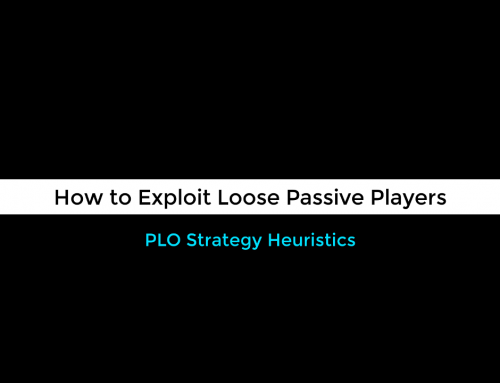Ralph Waldo Emerson
A good deal of hocus-pocus clouds many betting lines in Pot-Limit Omaha. The exact bet size to use for a given situation often seems quite arbitrary. But this is to be expected! Seeming arbitrary is not the same as being arbitrary. If you haven’t done the math, why should you know the best bet size? Experience you say?
Then consider this: There is enough variance in poker (No kidding, right?!) that your subconscious mind is often going to mistakenly attribute profitable events to being a causal result of the betting line you chose. Thus whether you are correct in your belief that you know the right bet size in a given situation is largely a question of luck.
This insight helps explain why players who go on sudden heaters up to high stakes often come crashing down soon after. They believe that they are justified attributing their success to strong betting lines and thus increase their confidence in sub-optimal plays. However the only conclusion they can justify from their empirical process is that their chosen betting lines did succeed on average over that sample. Not why.
Rather than rely on the vagaries of chance, we shall seek to make the machinery underlying a given better decision more definite. If we understand the structure of the game we can have confidence in the strength of our betting lines.
In this article I want to clear away some of the haze surrounding betting to induce on the river. Specifically, we’re going to provide a mathematical basis for judging when betting to induce is superior to a simple large bet for value.
The River Model
We’re going to model this situation with a simple equation so let us take a moment to declare our variables:
N = Induce bet size
V = Value bet size
f(RN) = frequency opponent raises inducing bet
f(RV) = frequency opponent raises value bet
f(CN) = frequency opponent calls inducing bet
f(CV) = frequency opponent calls value bet
Since we have assumed we have the best hand on the river we don’t need to include in our calculation the $1,000 already in the pot that we always win
So if we bet N, our opponent will put in an additional 1000 + 3N when he raises.
If we bet pot (V – $1,000), our opponent will put in an additional 4000 when he raises.
Relative EV- Don’t calculate more than you have to
“How often must our opponent raise the inducing bet compared to the value bet in order to make inducing more profitable?”
Thus rather than calculate two distinct absolute EVs for potting the river and betting small respectively, we are going to calculate the relative EV of inducing versus value betting. This will make our starting equation far more simple:
Relative EV = EV(Inducing) – EV(Value betting) = N*f(CN) + (1000 + 3N)*f(RN) – V*f(CV) – (1000 + 3V)*f(RV)
Set V = 1000 and we find…
Relative EV = N*f(CN) + (1000 + 3N)*f(RN) – 1000*f(CV) – 4000*f(RV)
So we have an equation for Relative EV as a function of 5 variables. However these variables are not all independent and so we can simplify this equation further.
To simplify, add a sprinkle of game theory
f(CV) + f(RV) = 0.5
f(CN) + f(RN) = 1 – N/(1000+N)
We now have an equation for Relative EV as a function of the 3 variables {N, f(RN), f(RV)}. We’ll simply the calculation further by setting the inducing bet size, N to 250 (25% of pot).
Since all we care about is the circumstances under which inducing becomes more profitable than value betting we can set the relative EV to zero. This enables us to answer the question,
“How often must our opponent raise the inducing bet compared to the value bet in order to make inducing more profitable?”
For N = 250
f(CN) = 1 – 250/1250 – f(RN) = 0.8 – f(RN)
Relative EV = 0 = 250*2 + 1750*f(RN) – 1000*3 – 4000*f(RV)
0 = 200 + 1500f(RN) – 500 – 3000f(RV) = 1500f(RN) – 3000f(RV) – 300
Finally, we conclude…
f(RN) = 0.2 + 2f(RV)
Interpreting the result
Remember that these are absolute frequencies not relative frequencies. So if he is raising the inducing bet 40% of the time he would need to also be calling 40% of the time and folding 20% of the time. So we care very much about the fraction of our opponent’s potential raises that could be value raises versus bluffs.
If your opponent has a lot of bluff-catchers in his range then you should avoid inducing and just bet large for value. If instead he has a lot of hands that cannot go to showdown, then the inducing bet has more potential upside. I say potential because lots of tight players will simply refuse to take the bait. Against nits you are better off potting the river and over-bluffing in an exploitative manner.
Other structural considerations
1) When we are in position
- If we are known to have two bet sizes on the river we have to balance three or four ranges when OOP (XC/Lead size 1/ Lead size 2/Sometimes XR). When IP, however, we only need to balance 2 ranges since there is no need to balance our check-back range.
- When we have drawn to get to a nut hand on the river and so it is crucial we get a certain threshold value from our strongest hands4. An inducing bet size risks winning a small pot on the river after having paid to draw out. This is less of a problem when drawing in position since we always get to observe our opponent’s river action.
2) When our range is not polarized
- We offer our opponent phenomenal odds on a call which reduces our permitted bluffing frequency dramatically. If our range has very few hands without show down value then we can utilize a small bet size on the river effectively.
- At river SPRs of around 1.75 a small bet may be the most likely way to get stacks in. This is because there is little enough remaining that our opponent’s shove will get the money in despite our small bet size, yet a pot-size value bet from us would discourage a bluff raise since it appears committing.
We’ve covered a lot of ground here in the theory behind betting to induce on the river. The way to improve on our work is to add some empirical data. If you enjoyed the article and would like to contribute to the discussion, please take the time to open up your database. Then, have a look at how frequently you are raised when you bet < 40% on the river and how often you are raised when you bet > 80% on the river. Please share the results in the comments below and use the equation we derived to draw your own conclusions!







Leave A Comment